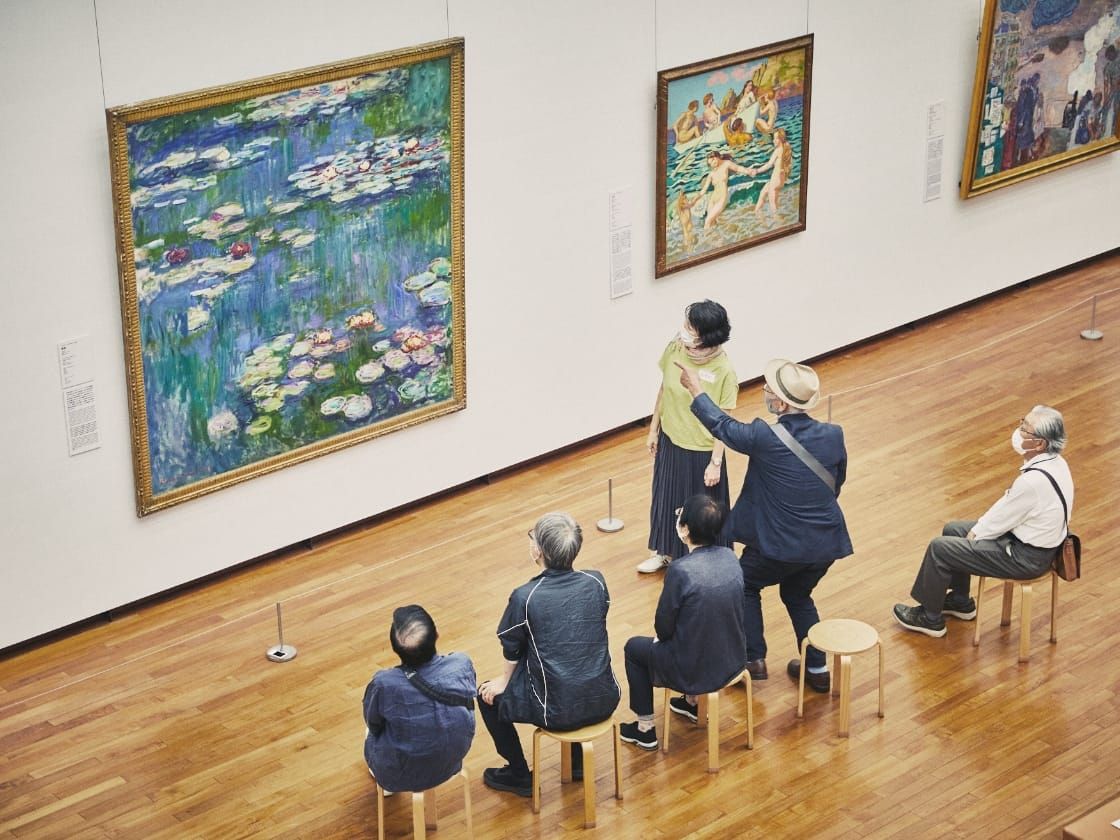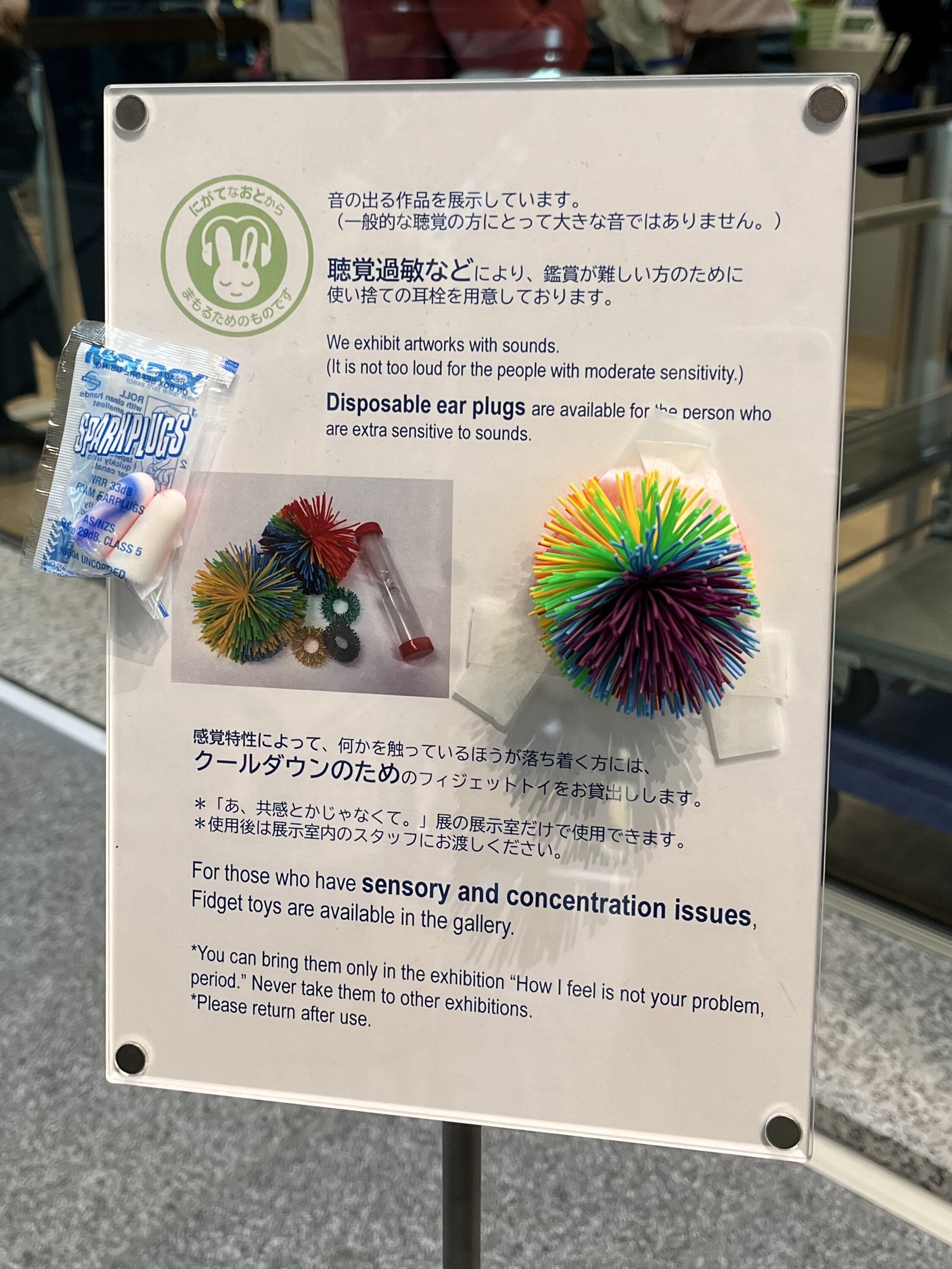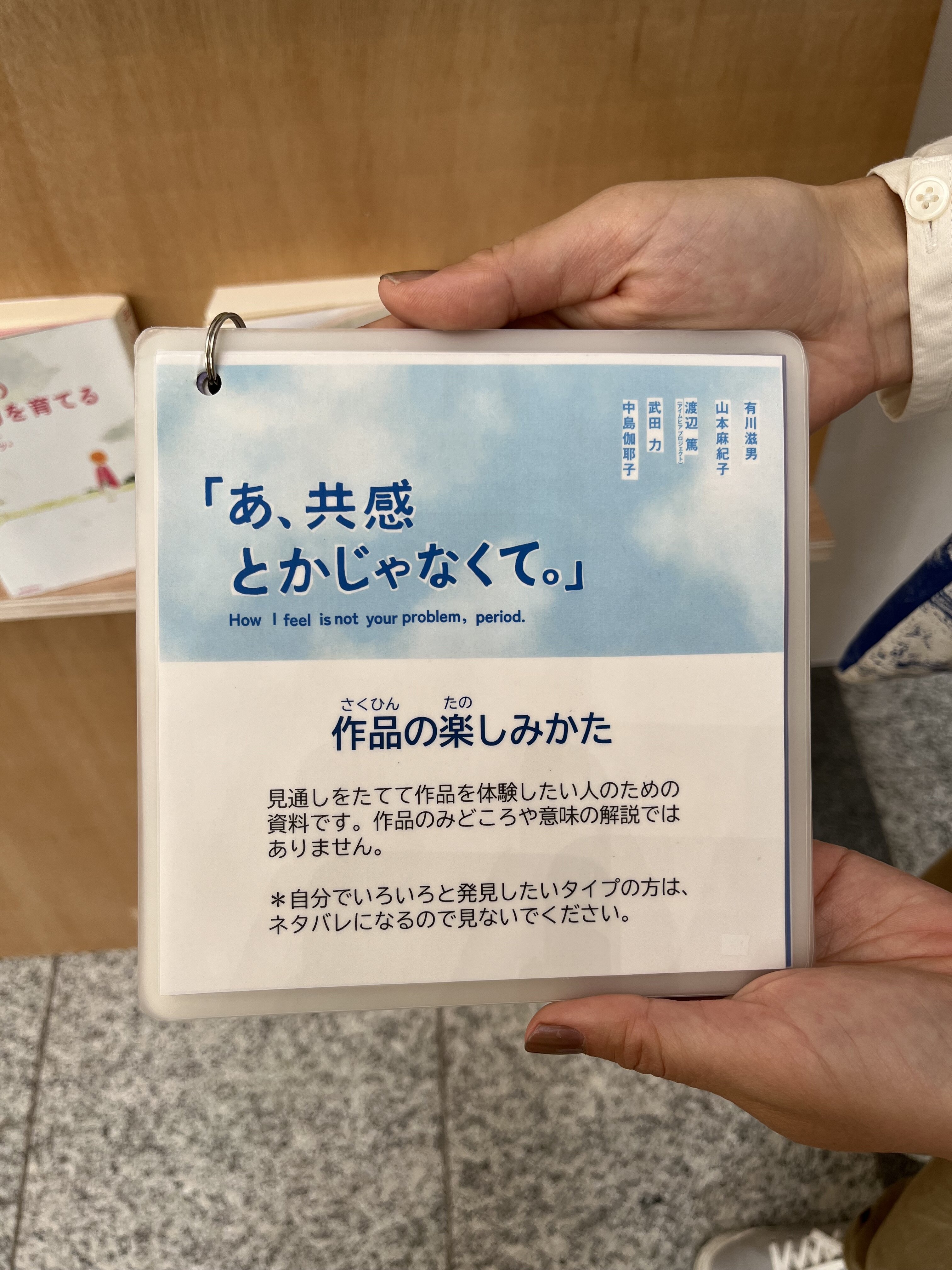Museums and Reasonable Accommodation—Based on Case Studies of People with Developmental Disabilities
ABLE ART JAPAN/
DEAI Research Lab. member
Takahashi Rika
The author’s sister looking at her own work shown at a venue (photo provided by the author)
In this DEAI* Research Report series, DEAI Research Lab members present accessibility case studies focused on museums.** In this article, which comprises Research Report 5, Takahashi Rika of ABLE ART JAPAN writes about a case study concerning a people with developmental disabilities.
*DEAI: DEAI is an acronym comprised of the first letters of the following four words: Diversity, Equity, Accessibility, and Inclusion. Launched in August 2023 as an activity of the National Center for Art Research, DEAI Research Lab conducts research on the concept of DEAI, which has become a global trend, and examines specific methods and requirements for raising the standards of museum accessibility. With participation from outside experts, in FY2023 the lab began to note specific cases and conduct activities to enrich understanding of reasonable accommodation in museums. For more information and explanations of the DEAI Research Lab and reasonable accommodation, please read the following article: Launch of the DEAI Research Lab and Reasonable Accommodation.
https://ncar.artmuseums.go.jp/en/reports/d_and_i/accessibility/post2024-1260.html
** ‘Museum(s)’ as used in this article includes not only art museums but also museums of the humanities such as archaeology, history, folklore, and literature museums; natural science museums devoted to natural history and science and engineering; aquariums; zoological and botanical gardens; and archives and memorial museums.
Introduction—Why I am Presenting a Developmental Disability Case Study
Since 2022, I have been a staff member at the ABLE ART JAPAN Tohoku Office, working on efforts that connect people with disabilities to arts and cultural activities, primarily based in Sendai, Miyagi Prefecture.
Disabilities and art: My interest in both of these came about when I was in my third year at university. I found out that my sister, who is three years older than me and has autism and intellectual disabilities, won a prize through an open appeal for submissions to an art center for the creative work that came out of her everyday actions. For as long as I could remember, my impression of my sister had been as “a very particular, troubled person,” so this event was something that made me think about what disabilities actually are. This time, while I sensed the possibilities of encounters between disabilities and art, my sister’s everyday life is in no small way made more difficult by her particularities, and I had some complicated feelings about how this side disappeared when her creations were taken up as works of art. Additionally, it was around this time that there were more opportunities to take my sister to art museums, but I experienced firsthand how museums that handle artwork can feel very far-removed for people like my sister, who may have difficulty speaking quietly, or who have severe behavioural disorders1). Since then, I came to have a strong interest in accessibility at art museums, and I now work as a member of “Museums for Everyone: The Museum Access Center Program,” a project in which ABLE ART JAPAN was commissioned by the Agency for Cultural Affairs to create museum environments open to all people, and to train people involved with this work.
In this report, I will discuss the reasonable accommodation case study that I actually experienced when I went to a museum with my sister, and present initiatives that connect museums and people with developmental disabilities.
A Reasonable Accommodation Case—Based on a Real-Life Experience
One of the FY2023 DEAI Research Lab. activities was to survey case studies of reasonable accommodation that actually took place at museums, and one of the cases I studied involved a real-life experience with my sister. In March 2024, the National Center for Art Research planned and produced The Handbook of Reasonable Accommodation, Learning from the Cases in the Museum. Case 5 (pp.18-19) of this handbook is based on that experience. In this report, I will discuss how we arrived at the reasonable accommodation.
1. Problems/Demands
In March 2022, my sister’s artwork was being shown at an exhibition in Shiga Prefecture, so we went as a family with her to see the exhibition. At the time, my sister was feeling very anxious about going to a new place.
People with developmental disabilities are said to often have difficulties in everyday life because their sensations (hearing, sight, smell, touch, and taste) are heightened, and this is called hyperesthesia. My sister has this condition, and many of her everyday difficulties are caused by noise sensitivity. Typically, people who are sensitive to noise have a hard time with sudden noises, such as the cry of a baby, the sound of a vacuum cleaner, noises at a supermarket, the sound of a balloon popping, and thunder. In my sister’s case, she particularly struggles with the sound of a popping balloon and enters into a panic when she even sees a balloon. Her anxiety grows when she goes to a new place because she worries about what to do if there are balloons there. This is why she puts on soundproofing “earmuffs” when we go to a new place. If she encounters something she dislikes, she can end up harming herself or others, and it can take a long time for her to calm down again.
To reduce the risk of coming into contact with balloons as much as possible, on this occasion our mother contacted the exhibition organiser ahead of time to ask. She sent an email asking if there were any artworks or decorations at the venue or on the way to the venue that used balloons.
▼
2. Dialogue
The contact person was a curator at an art museum that was a part of the venue for the exhibition, and he sent a few emails back and forth. Regarding the original request about wanting to know about the use of balloons, the curator was kind enough to check whether there were any balloons inside of or along any of the routes between the venue locations (the exhibition was held at three different venues interspersed within walking distance of another within the city). Furthermore, he asked follow-up questions, such as if my sister had a problem with noises other than balloons, and if she would be alright with artworks that did not have balloons but that did make noises. He also said that he could send photos of the venue ahead of time, and that if there were any important points that were difficult to put into writing, he could talk about it on the phone.
▼
3. Mutual Agreement
Thanks to the curator who acted as a contact person and confirmed the situation, we were able to tell my sister ahead of time that there would be no balloons at the venue. On the day of our visit, the four of us were able to see the exhibition with peace of mind.
For my sister, the presence of something she dislikes can present an obstacle to her visiting a museum. This case was an example where I had that obstacle removed as much as possible.
The author’s sister arriving at the venue showing her artwork (photo provided by the author)
What I Learned from This Real-Life Experience of Reasonable Accommodation
There is more to this story. The curator who became our point of contact later wrote about this incident in a free newspaper that the art museum publishes, in a column about reasonable accommodation. One section made a particular impression on me:
“The question of ‘whether or not there are any balloons’ is an extremely individual need, and to most people it would not matter at all. However, sometimes, needs are fatally individual. Setting aside the formalisation of ‘this kind of thing should be done for this particular person with disabilities,’ I think we should confront the needs of individuals, and think about that kind of cross-linking method on a case-by-case basis.” 2)
Even if some people with noise sensitivity have a hard time with the sound of a balloon popping, there may be few who enter into a panic just upon seeing a balloon. When people express the intention to remove the societal barriers around people with disabilities, they may sometimes be confused by the details of their needs because they have not seen another case like it, or because they do not know that person well enough. However, instead of dismissing them because there “is no precedent for it” or because “we can’t give special treatment,” I really felt once again that what is important in reasonable accommodation is an attitude of listening and conducting dialogue to find out what the person is asking for and what they have trouble with.
Museum Initiatives for People with Developmental Disabilities
Even at Japanese museums, little by little there are more initiatives being made to improve the environment for people with developmental disabilities. Below are a few examples.
・Social Story
This is a tool primarily to support people with developmental disabilities and their families, so that they can understand social scenarios and rules in advance. There are also cases called “Social Guide” and “Social Narrative.” At the National Center for Art Research and the Mie Prefectural Art Museum, they provide tools that present simple Japanese and photos of what people can expect to do at the art museum, to give them an idea of what it is like.
National Museum of Art edition “Social Story: My First Art Museum Visit”
→https://ncar.artmuseums.go.jp/activity/d_and_i/accessibility/
Mie Prefectural Art Museum “Social Guide”
→https://www.bunka.pref.mie.lg.jp/art-museum/000248624.htm
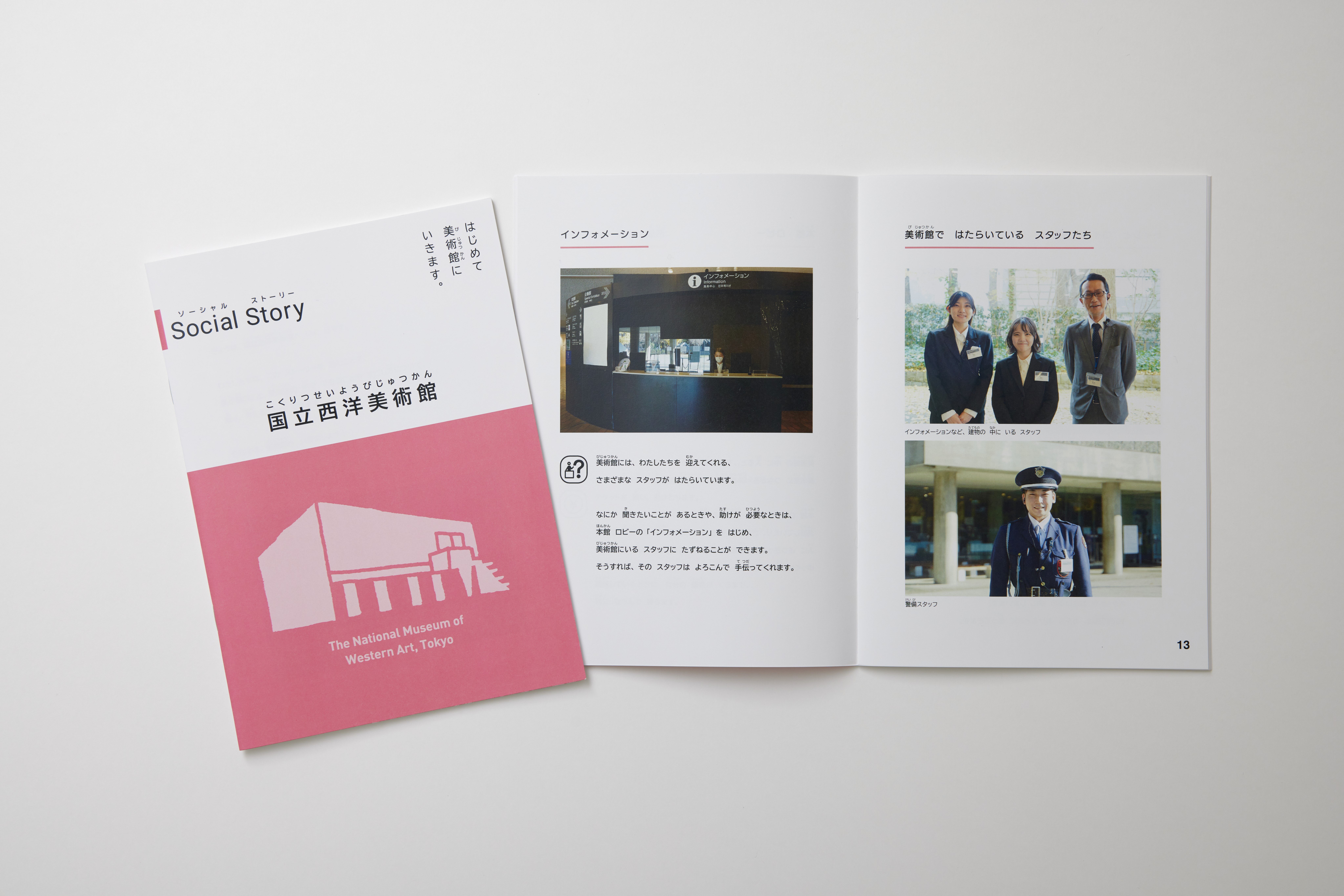
Booklet “Social Story: My First Art Museum Visit, the National Museum of Western Art”
・Calm Down Spaces
These are spaces for people who may be feeling unwell due to hyperesthesia, or anxious about being in a new place; they are areas in which people can isolate themselves from outside noises and the gaze of others and return to a calmer state of mind. In some cases, they are simple spaces made with partitioning; in other cases, the person may be shown to an empty meeting room or other space, and still in other cases there is a dedicated space set up called a “calm down room.”
*For details on calm down rooms, see DEAI Research Report 4, “Initiatives for People with Hyperesthesia Symptoms.”
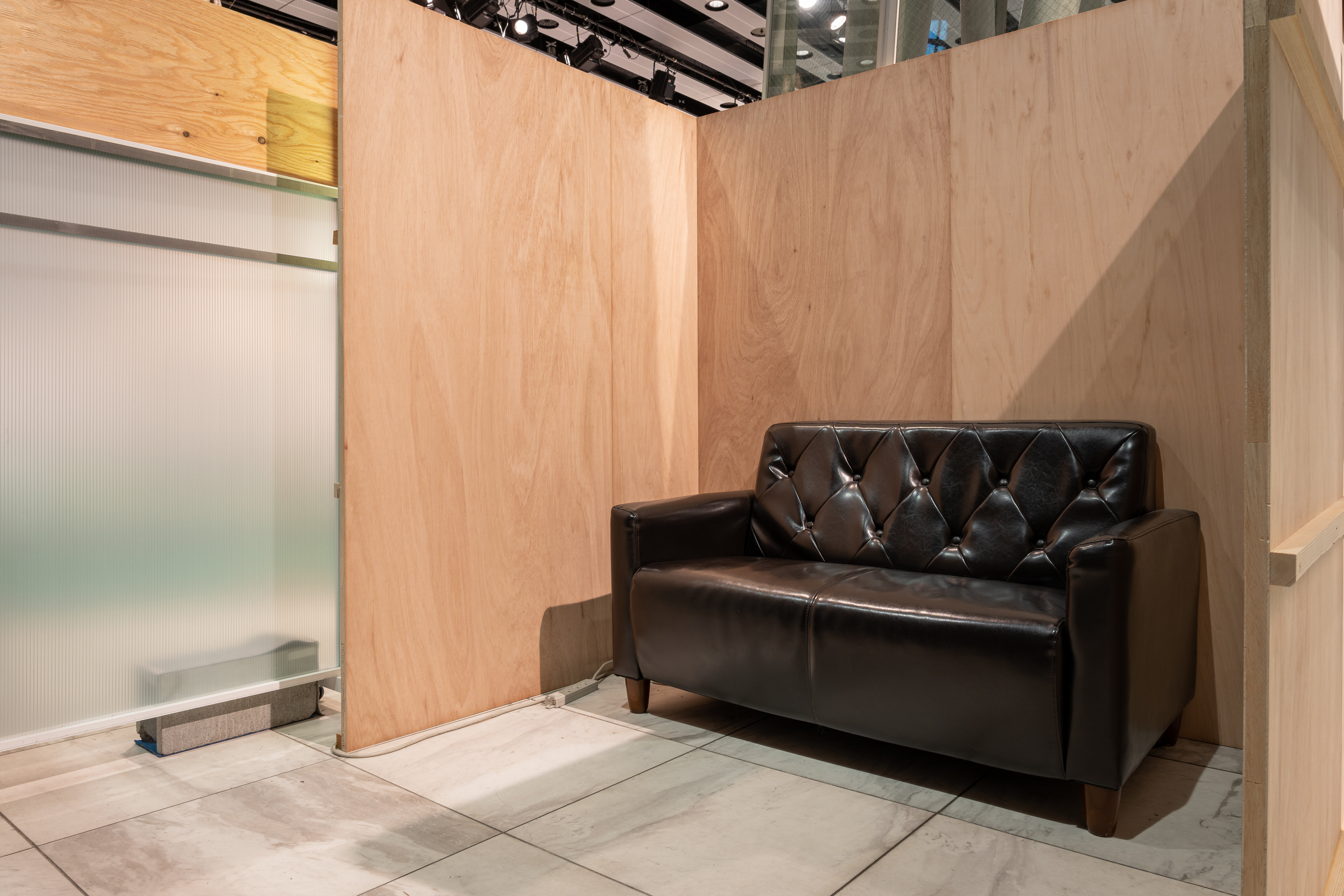
Special exhibit at a related event planned and run by Museums for Everyone and held at Sendai Mediatheque; a calm down space set up at “Jozenji Putter Golf??? Club!!” (2023, photo by Izuru Echigoya)
・Sensory Map
This is a map featuring information about senses, such as sound and light. By looking at this map ahead of time, users can avoid places that have things they dislike and take note of rest areas. The Tokyo National Museum provides a sensory map that you can view on their website.
Tokyo National Museum Sensory Map
→https://www.tnm.jp/modules/r_free_page/index.php?id=2579
Examples of Initiatives for Special Exhibitions
While the above examples are undertaken as a part of environmental preparations for the entire museum, there are also examples of initiatives that were made to fit the content of special exhibitions.
At the special exhibition “How I feel is not your problem, period.” held at the Museum of Contemporary Art Tokyo from July to November 2023, they made an effort to improve accessibility for people who were not used to going to art museums, such as those who had hyperesthesia or who were very anxious about going to new places3). For example, they distributed earplugs to people with noise sensitivity, loaned “fidget toys” to help people who feel better when they are touching something, and created social narratives for people who needs notice beforehand to suggest how to spend time in the exhibition rooms and how to enjoy the works of art.
Are Museums Places That Need to Be Quiet?
Another thing I would like to consider in this report is how places like museums, in which being quiet has become the tacit rule, handle people who spontaneously vocalise things. My sister has difficulty speaking quietly and always speaks to herself, so my family had avoided going with her not only to museums but also cinemas, hospitals, and other places in which one needs to be quiet as we feared she would cause a nuisance. In the Museums for Everyone survey, there was also a remark made by a mother whose son had developmental disabilities: “Rather than families of children with developmental disabilities having trouble, the current reality is that many people have given up on going places.”
At one welfare office, an employee who wanted to take her clients to a local museum contacted them in advance to ask about taking a group. They mentioned that one of the people had the trait of spontaneously vocalising, and the response she received was, “Please be careful as much as possible, because there are other visitors.” The employee was left with the impression that it was difficult to feel that she was being welcomed.
Furthermore, at “Museums for Everyone” we cooperate in trainings related to reasonable accommodation for museum employees, and when they have someone whose disability causes them to spontaneously vocalise, we have been told that they do not know how to approach them. While they want to welcome people with these disabilities, they may feel that it is difficult to respond when they have to be thoughtful towards other visitors as well.
In my sister’s case, since she often understands things shown visually, when we want her to be quiet, we communicate this to her by showing her a card that has a printed illustration of a person gesturing “quiet” with his index finger held over his lips.
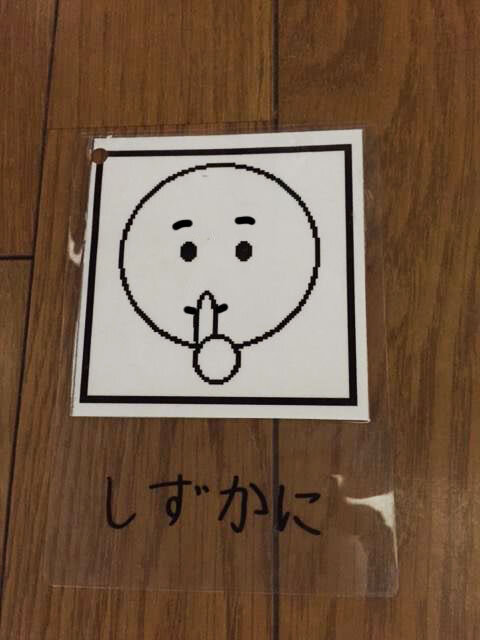
Homemade care (photo provided by the author)
When it seems from someone’s vocalisation that he is feeling anxious, I think that using tools like these to communicate gently, or showing him to a calm down space or an area where he can talk, would lead the person and those escorting him to truly feel that they were being well received. There are also more initiatives such as special showings when museums open on their usual day off for people with disabilities, or set days when it is alright to talk in the museum.
Conclusion
In 2023, ABLE ART JAPAN visited the Miyagi Museum of Art with members of a studio operating in Sendai, and a special showing of the permanent exhibition was conducted. This studio conducts activities with the goal of having “people with and without disabilities doing creative work,” and its members are all different in terms of the characteristics of their disabilities and their ages. This program involved breaking up into groups of three to four people and appreciating the art while conversing with each other. However, on taking a closer look, while some people were good at communicating with words, others communicated their intentions more through facial expressions and gestures than through words, and some groups did not converse much. Some elementary and high school students hardly entered the group conversations at all, instead communicating what they saw in the paintings by quietly drawing with pencils on the paper that was handed out ahead of time, and then communicating through their drawings. At a program in which the idea was to appreciate works of art while having a dialogue with multiple people, the emphasis was on language-based interactions, but people noticed that there were still many more ways to enjoy the artwork. In this way, I noticed the possibility that, when people who have different traits gather, the ways they see the works of art begin to expand.
Providing reasonable accommodation is related to human rights, but rather than thinking stiffly that things need to be done a certain way, or putting ourselves on guard, the simple act of “enjoying new encounters” is something that might allow museums to open up to even more different types of people.
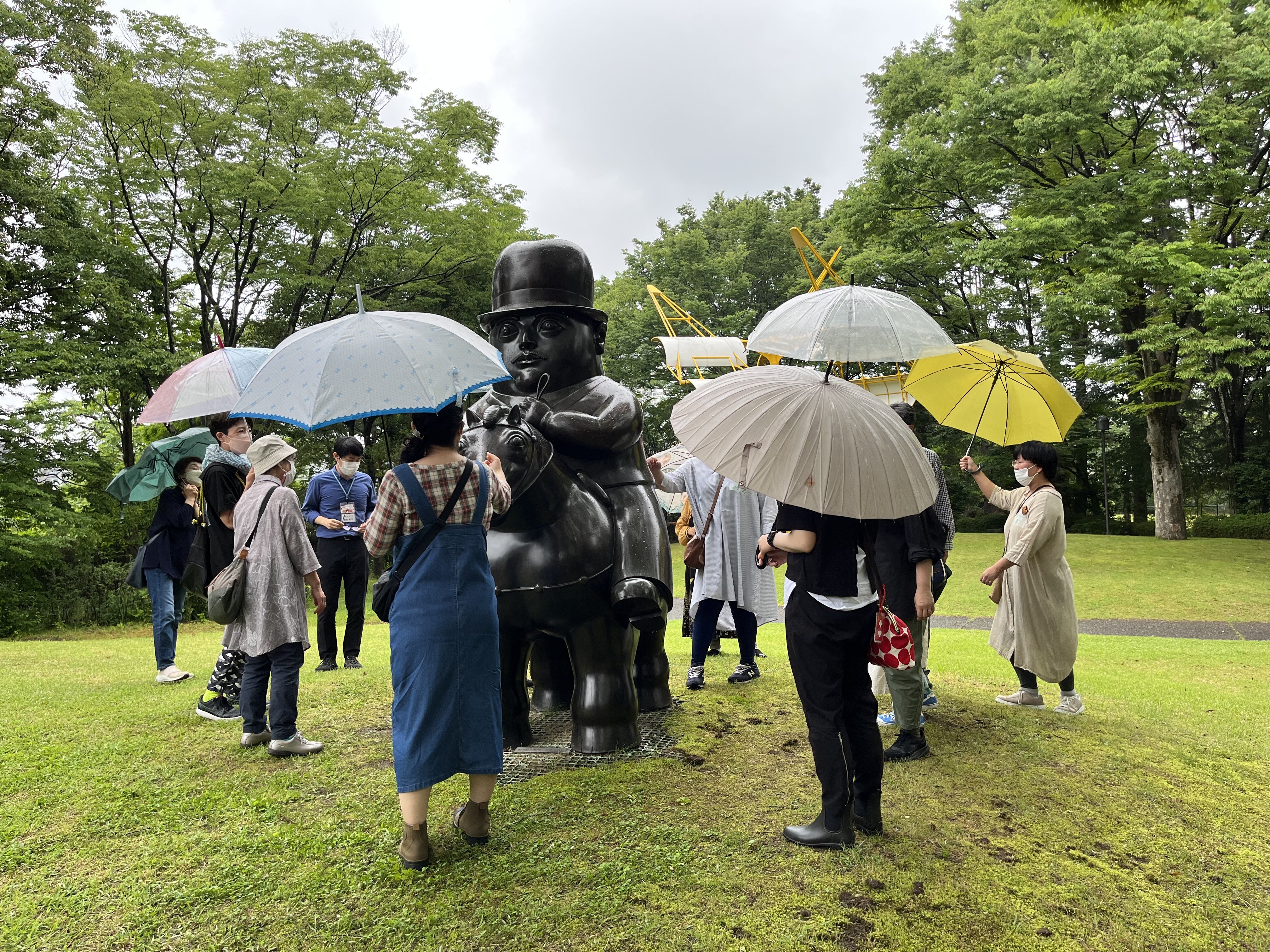
Special showing at the Miyagi Museum of Art (photo provided by the author)
Notes
1)“Severe behavioural disorders” refers to “a condition in which specially-considered support is necessary due to the considerably high frequency of behaviours that affect the lives of the person in question or those around them, such as self-injury, injury to others, fixations, damaging things, sleep disorders, parorexia, and hyperactivity.”
Ministry of Health, Labour and Welfare “October 4, 2020 1st Study Group on Community Support Systems for People with Severe Behavior Disorders, Reference Material 3”
https://www.mhlw.go.jp/content/12401000/000995582.pdf(last viewed September 17, 2024)
2)Art Brut Colum Vol. 19 “On the Distances between People with Disabilities and Art Appreciation – Considering Cross-Linking Methods with Readings of the Law as a Guide,” Yamada Sou, Borderless Art Museum NO-MA Newsletter noma noma VOL.29, March 2022
https://no-maarchive.com/cms/wp-content/uploads/2022/04/vol29.pdf(last viewed September 17, 2024)
3) For details see Annual Report 2023 Bulletin No.26, Museum of Contemporary Art Tokyo p.124
Design for Neurodiversity and Inclusion at “How I feel is not your problem, period.” Yamaki Kasumi
https://www.mot-art-museum.jp/images/annual_report_202302.pdf(last viewed September 17, 2024)
Editorial Support: Yonezu Itsuka







